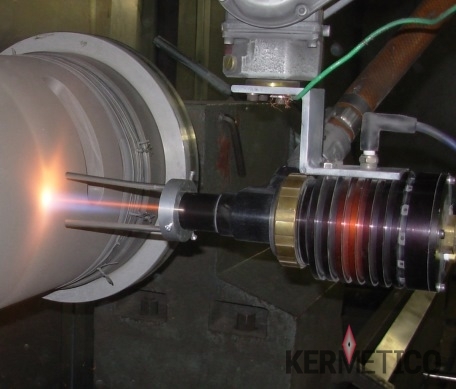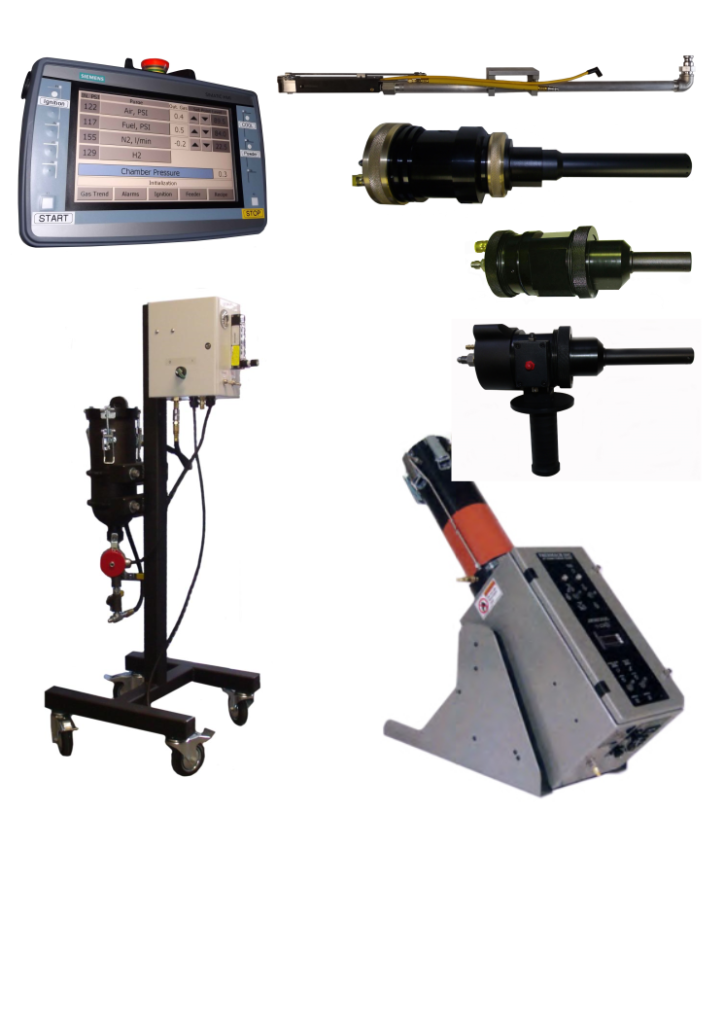Kermetico AK – Universal HVAF Machines To Spray A Variety Of Metals And Carbides: From MCrAlY And Super Stainless To Cr₃C₂-NiCr And WCCoCr
Kermetico thermal spray equipment. AK HVAF machines work reliably with LPG fuels, such as propane, propane-butane, propylene and MAPP-gas as well as with methane and natural gas.
Our HVAF machine sprays metals and carbides at optimal temperature, not overheating it. That is how we are spraying bulk-like gas and liquid impermeable wear and corrosion resistant coatings.
Given the large variety of different guns in our AK HVAF product line, we have a wide tuning range that allows for thermal spraying metals, MCrAlY, chromium carbide, tungsten carbide and other stainless steel, nickel and cobalt-based coatings.
Each AK machine is on-site friendly, wheel-mounted and does not need a water chiller.
Our guns are inexpensive and easy to changeover, so we recommend having several guns at one facility to achieve the best results: universal AK6 + AK-ID for bores and AK-HH for manual coating jobs.
Review our Convertible equipment working in HVOF or HVAF modes.
The Use Of Propane, Propane-Butane, Propylene, MAPP-Gas, Methane And Natural Gas For High Velocity Thermal Spray Coatings
Propane
C3H8, one of the liquefied petroleum gases (LPG) group, a by-product of natural gas processing and petroleum refining. Specific heat capacity – 1.67 KJ/ (Kg*K).
Propylene
C3H6, also known as propene or methyl ethylene, has a slightly lower boiling point than propane and is thus more volatile. Specific heat capacity – 1.5 KJ/ (Kg*K).
Propane-Butane
is a mix of propane and butane. In some countries, it is much less expensive and easier to find than pure propane.
MAPP gas
is a trademarked name, belonging to The Linde Group for a fuel gas based on a stabilized mixture of methylacetylene (propyne) and propadiene. The name comes from the original chemical composition, methylacetylene-propadiene propane. “MAPP gas” is also widely used as a generic name for UN 1060 stabilized methylacetylene-propadiene (unstabilized methylacetylene-propadiene is known as MAPD). In the spring of 2008, the only remaining plant in North America discontinued true MAPP gas production. Current products labeled “MAPP” are, in fact, MAPP substitutes. These versions are stabilized liquefied petroleum gas (LPG) with high levels of propylene.
Methane, CH4, is the main component of natural gas. Specific heat capacity – 2,22 KJ/ (Kg*K).
Natural gas
is a naturally occurring hydrocarbon gas mixture consisting primarily of methane, but commonly including varying amounts of other higher alkanes, Specific heat capacity – 2,34 KJ/ (Kg*K).
It is possible to pre-set our AK equipment to work with any of these gases, some of them, like propane-butane or natural gas, will need additional hardware to prepare it properly.
The Advantages Of Kermetico HVAF AK Spray Machines Compared To Other Systems
The quality and efficiency of Kermetico AK equipment is the result of the relatively low combustion temperature of an air-fuel mixture combined with the axial injection of the feedstock through the long combustion chamber, where the low gas velocity provides sufficient time for the powder particles gradual heating. The materials’ acceleration occurs in the nozzle that has a large diameter. The large diameter of the nozzle is needed to pass through the volume of nitrogen present in the combustion air. It also ensures that the nozzle walls do not interact with the particles, allowing the use of a nozzle that is as long as needed for feedstock acceleration, typically from 800 to over 1,000 m/s (2,625-3,280 ft./sec.). The Ceramic Catalytic Insert is used in the combustion chamber to provide a broad range of stable combustion parameters.
The Kermetico AK HVAF system deposits coatings with 5-6 times higher spray rates, 20-30% higher deposition efficiency, 30% less deviation than any HVOF system. When choosing a Kermetico AK system, a job shop gains at least a 50% cost advantage over HVOF competitors and gains an additional coating quality advantage as a “bonus.”
The combustion temperature in air-fuel mixtures is typically 1,000oC (1,832°F) lower than in oxygen-fuel combustion. This lower temperature is ideal for the gradual heating of the feedstock particles of metals and cemented carbides to or slightly above the metals’ melting temperature.
The initial oxygen content in the combustion gas mixture in our HVAF process has only 1/5 of the oxygen content in any HVOF process.
Both factors prevent the oxidation of metals and the decomposition of carbides. These factors allow for the retention of the original ductility of the powder feedstock material in the applied coating, even when the hardness of the cemented carbide coating exceeds 1,600 HV300.
Heating of the spray particles in the combustion chamber occurs at high pressure, where heat transfer is the most efficient. The size of the chamber provides a long residence time for the spray particles to heat. Thus the energy transfer efficiency is increased noticeably compared to other high-velocity spraying methods, resulting in much higher spray rates. Heating efficiency is a primary reason for the reduced cost of the Kermetico AK applied coatings.
The large diameter of the nozzle eliminates its length limitations, known to other guns. The spray particles can be accelerated up to the gas velocity.
The diameter of the spray particle jet is several times smaller than the nozzle diameter. The influence of the nozzle walls on the spray particle velocity is negligible, providing even acceleration of the particles and improved consistency of the coating structure.
| WCCoCr 86/10/4 Coating Feature | Typical HVOF | Kermetico HVAF Mode | ||
|---|---|---|---|---|
| Economy | Balanced | Ultra | ||
| Deposit Efficiency, % | 40-55 | 60-70 | 48-58 | 36-42 |
| Hardness, HV300 | 1,050-1,250 | 1,050-1,250 | 1,250-1,350 | 1,350-1,600+ |
| Apparent Metallographic porosity | < 0.8 | < 0.8 | < 0.5 | < 0.3 |
| Bond Strength, PSI(MPa) | 12,000+ (80+) | |||
| Range of as-sprayed roughness, µm (µ in.) | 3.5 - 4.5 (150-180) | 1 - 3.2(40-130) | ||
The Option For Hydrogen Injection Provides Better Particle Temperature Control And Prevents Materials Oxidation
The AK guns may be used with hydrogen injection.
The control of hydrogen injection provides an additional tool for the particle temperature regulation due to the high thermal conductivity of hydrogen as well as the additional protection of the spray material from oxidation.
The average flow of hydrogen in an AK gun is under 20 SLPM, and it has a negligible effect on the combustion process and particle velocity.
Combustion Chamber Pressure Measurements And Safety Interlocks
The AK guns provide the means for the measurement of combustion chamber pressure, which is an essential technological parameter of the HVAF spray process.
We use the data from the combustion chamber pressure transducer for the detection of the powder carrier gas flow during the gun ignition process. This allows creating a safety interlock for preventing gun ignition if no flow of carrier gas was detected preventing the possibility of a flash-back into the powder hose and flow of combustible gases into the powder feeder.



